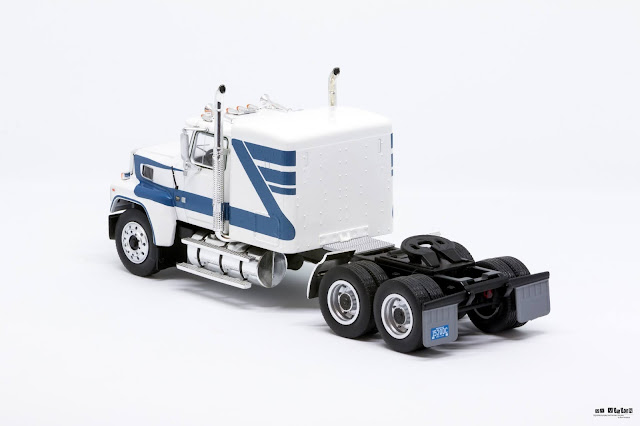Saturday 15 May 2021
The Ford L-series (also named Ford Louisville or, for the 1990s aerodynamic models, Ford Aeromax) is a range of heavy-duty trucks that were assembled and marketed by Ford between 1970 and 1998. Ford had been producing their "Heavy Duty" trucks since 1948 and their "Super Duty" lineup since 1958 marketed by various GVW ratings. Truck weight classifications 1-8 were a new concept brought about by the DOT National Highway Administration. The first dedicated Class 8 truck produced by the company, the L-series range replaced the F-series "Super Duty" and N-series (short conventional derived from the F-series). Produced as both straight trucks and semitractors, the Ford L-series encompassed a wide range of models through the Class 6-8 GVWR ratings in medium-duty, severe-service, and vocational applications. The line would become one of the most popular series of trucks Ford ever produced.
The L series was produced in the Kentucky Truck Plant near Louisville, Kentucky, which gave rise to the nickname "Louisville Line" trucks; as part of a 1996 redesign, part of the model line officially took on the Louisville nameplate.
Following the sale of the Ford heavy-truck line to Freightliner in 1996, the L-series was discontinued by Ford at the end of 1998. Freightliner would concurrently take over production of the Ford L-series, opening its Sterling Trucks subsidiary; the L-series became the Sterling A line, Acterra, and L line, remaining in production until 2009 when Sterling Trucks closed operations.
In 1963, Ford produced its first short BBC conventional with the introduction of the N-series Super Duty, supplementing the Super Duty models of the F-series. As Ford did with the H-series cabover (derived from the C-series and nicknamed the "Two-Story Falcon"), an all-new chassis raised the cab upward; while sharing its grille with the H-series, the N-series shared its cab with the F-series pickup trucks.
By the 1960s, Ford sought to modernize and streamline its heavy-truck line. In 1961, the heavy-duty F-series (F-750 to F-1100) became a larger, separate model line along with introduction of the all new H-series Linehauler. In 1966, the H-series was replaced by the all-new W-series cabover. In a change from adapting the F-series to become a heavy truck and to replace the N-series, Ford began design work on an all-new truck range, which became the L-series. With an all-new heavier-duty chassis, the L-series also featured a larger cab; to improve serviceability, the design included a front-hinged hood.
For 1970, the L-series was introduced in four size ranges, two hood lengths and grille styles, and with single or tandem (denoted by the "T" in the model designation) rear axles. Powertrains included a wide range of gasoline and diesel engines, based on GVWR.
In 1971, Ford introduced a set-back front axle configuration. For the rest of the 1970s, the L-series saw few major changes. In 1976, the LL/LTL-9000 was introduced. Designed as a truck for long-haul drivers, the LTL-9000 was a competitor to the GMC General, Kenworth W900, Mack Super-Liner, and Peterbilt 359. Fitted with a set-forward front axle and a longer hood, this version had more room for larger powertrains. In 1978, Ford gave the LL/LTL-9000 its own grille and headlight styling, including one of the first uses of the Ford Blue Oval in North America.
Although the L-series would see few revisions throughout its production, elements of its design would see use in other Ford vehicles. In 1974, the W-series cabover received a larger grille similar to the chrome version on the L series. For 1978, the F-series/Bronco grille was given a similar egg-crate grille pattern. In the 1980 redesign of the medium-duty F- series, the hexagonal shape of the grille was carried over; it is a theme used in all Super Duty trucks since their 1998 introduction.
In 1984 (as 1985 model year), the rest of the L-series became one of the last North American Fords to adopt the Ford Blue Oval; as with the LTL-9000, it was placed above the grille. In 1988, the L-series changed its grille design from an egg-crate design to that of horizontal chrome bars; the Ford Blue Oval became centered. In addition, rectangular headlights became standard in 1991.
1992 saw the introduction of the set-back front axle version of the LL/LTL-9000, designated the LLS and LTLS-9000, along with the corresponding Aeromax versions that had more aerodynamic bumpers and optional chassis skirting.
Technical data:
- engine: V8
- capacity: 9300 cc
- horsepower: 365 HP
- gearbox: 13+1
- top speed: 100 km/h







Brak komentarzy:
Prześlij komentarz